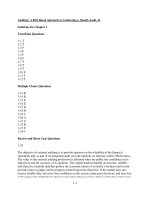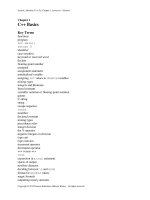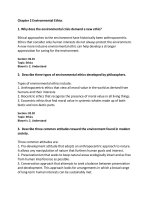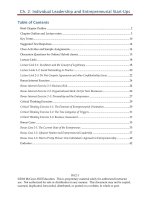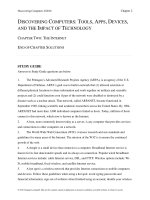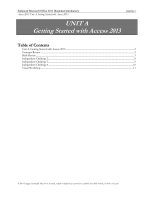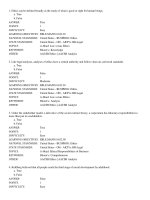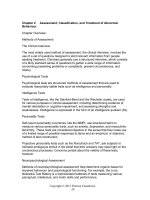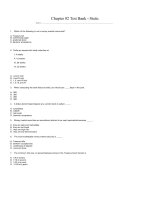Test bank and solution manual of ch02 assessment classification and treatment of abnormal behavior (1)
Bạn đang xem bản rút gọn của tài liệu. Xem và tải ngay bản đầy đủ của tài liệu tại đây (167.09 KB, 19 trang )
Chapter 2
Behaviour
Assessment, Classification, and Treatment of Abnormal
Chapter Overview:
Methods of Assessment
The Clinical Interview
The most widely used method of assessment, the clinical interview, involves the
use of a set of questions designed to elicit relevant information from people
seeking treatment. Clinicians generally use a structured interview, which consists
of a fairly standard series of questions to gather a wide range of information
concerning presenting problems or complaints, present circumstances, and
history.
Psychological Tests
Psychological tests are structured methods of assessment that are used to
evaluate reasonably stable traits such as intelligence and personality.
Intelligence Tests
Tests of intelligence, like the Stanford-Binet and the Wechsler scales, are used
for various purposes in clinical assessment, including determining evidence of
mental retardation or cognitive impairment, and assessing strengths and
weaknesses. Intelligence is expressed in the form of an intelligence quotient (IQ).
Personality Tests
Self-report personality inventories, like the MMPI, use structured items to
measure various personality traits, such as anxiety, depression, and masculinityfemininity. These tests are considered objective in the sense that they make use
of a limited range of possible responses to items and an empirical, or objective,
method of test construction.
Projective personality tests such as the Rorschach and TAT, ask subjects to
interpret ambiguous stimuli in the belief that their answers may shed light on the
unconscious processes. Concerns persist about the validity of these tests,
however.
Neuropsychological Assessment
Methods of neuropsychological assessment help determine organic bases for
impaired behaviour and psychological functioning. For example, the Luria
Nebraska Test Battery is a sophisticated batteries of tests measuring various
perceptual, intellectual, and motor skills and performance.
Copyright © 2013 Pearson Canada Inc.
20
Behavioural Assessment
In behavioural assessment, test responses are taken as samples of behaviour
rather than as signs of underlying traits or dispositions. The behavioural
examiner may conduct a functional assessment, which relates the problem
behaviour to its antecedents and consequences. Methods of behavioural
assessment include behavioural interviewing, self-monitoring, use of analogue or
contrived measures, direct observation, and behavioural rating scales.
Cognitive Assessment
Cognitive assessment focuses on the measurement of thoughts, beliefs, and
attitudes in order to help identity distorted thinking patterns. Specific methods of
assessment include the use of a thought record or diary and the use of rating
scales such as the Automatic Thoughts Questionnaire (ATQ).
Physiological Measurement
Measures of physiological function include heart rate, blood pressure, galvanic
skin response (GSR), muscle tension, and brain wave activity. Brain-imaging
techniques such as EEG, CAT scans, PET scans, MRI, fMRI , BEAM, and MEG
probe the inner workings and structures of the brain.
Classification of Abnormal Behaviour
The Diagnostic and Statistical Manual of Mental Disorders (DSM), is the most
widely accepted diagnostic system, now in its fourth edition. Another widely used
system is the International Classification of Diseases (ICD) published by the
World Health Organization. Now, in its tenth edition, and with Canadian
enhancements and modifications, the system is known as the ICD-10-CA, which
has been adopted as the Canadian standard for coding, reporting, and tracking
health information.
The DSM uses specific diagnostic criteria to group patterns of abnormal
behaviours that share common clinical features and a multiaxial system of’
evaluation. Strengths of the DSM include its use of specified diagnostic criteria
and a multiaxial system to provide a comprehensive picture of the person’s
functioning. Weaknesses include questions about reliability and validity, and
about the medical model framework.
Methods of Treatment
Psychotherapy involves a systematic interaction between therapists and clients
that incorporates psychological principles to help clients overcome abnormal
behaviour, solve problems in living, or develop as individuals. The various
approaches to psychotherapy employ theory-based specific treatment factors
and nonspecific factors such as the quality of the therapeutic relationship and the
installation of hope.
Copyright © 2013 Pearson Canada Inc.
21
Biological Therapies
Biological approaches include drug therapy, electroconvulsive shock therapy
(Ed), and psychosurgery. Minor tranquilizers such as Valium may relieve shortterm anxiety but do not directly help people solve their problems. Neuroleptics
help relieve flagrant psychotic features, but regular use of most antipsychotic
drugs has been associated with a risk of disabling side effects. Antidepressants
have been shown to be effective in treating depressive disorders, and lithium has
been shown to be effective in treating bipolar disorder. ECT is often associated
with dramatic relief from severe depression, but questions remain about side
effects. Psychosurgery is conducted only rarely because of adverse
consequences. Deep brain stimulation involves implanting electrodes within the
part of the brain that affects mood.
Psychodynamic Therapies
Psychodynamic therapies originated with psychoanalysis, the approach to
treatment developed by Freud. Psychoanalysts use techniques such as free
association and dream analysis to help people gain insight into their unconscious
conflicts and work them through in the light of theft adult personalities. More
recent psychoanalytic therapies are generally briefer and less intensive.
Behaviour Therapy
Behaviour therapy applies principles of learning to help people make adaptive
behavioural changes. Behaviour therapy techniques include systematic
desensitization, gradual exposure, modeling, aversive conditioning, operant
conditioning approaches, social skills training, and self-control techniques.
Humanistic-Existential Therapies
Humanistic approaches focus on the client’s subjective, conscious experience in
the here and now. Rogers’s person-centered therapy helps people increase theft
awareness and acceptance of inner feelings that had met with social
condemnation and been disowned. The effective person-centered therapist
possesses the qualities of unconditional positive regard, empathic understanding,
genuineness and congruence.
Cognitive-Behavioural Therapies
Cognitive therapies focus on modifying the maladaptive cognitions that are
believed to underlie emotional problems and self-defeating behaviour. Ellis’s
rational-emotive therapy focuses on disputing the irrational beliefs that occasion
emotional distress and substituting adaptive behaviour for maladaptive
behaviour. Beck’s cognitive therapy focuses on helping clients identify,
challenge, and replace distorted cognitions, such as tendencies to magnify
negative events and minimize personal accomplishments. Meichenbaum’s
cognitive-behavioural therapy attempts to integrate behavioural principles and
Copyright © 2013 Pearson Canada Inc.
22
cognitive techniques in a way that reduces or eliminates problematic behaviours
and changes dysfunctional thoughts and cognitions.
Eclectic Therapy
Eclectic therapists make use of multiple models of psychotherapy. In technical
eclecticism, therapists use techniques from different approaches without
necessarily adopting the theoretical models on which they were based. In
integrative eclecticism, therapists attempt to synthesize and integrate diverse
theoretical models.
Group, Family, and Marital Therapy
Group therapy has several advantages over individual treatment, such as
reduced costs, opportunities for shared learning experiences and mutual support,
and increased utilization of scarce therapist resources. The particular approach
to group therapy depends on the orientation of the therapist.
Family therapists work with conflicted families to help them resolve their
differences. Family therapists focus on clarifying family communications,
resolving role conflicts, guarding against scapegoating individual members, and
helping members develop greater autonomy. Marital therapists focus on helping
couples improve their communications and resolve their differences.
Computer-Assisted Therapy
Computer-based interventions and therapy come in all forms, from online
cognitive-behavioural therapy with a live therapist using a video-chat service to
self-guided behaviour therapy for children with anxiety. Computer-based
interventions for various disorders have the potential to dramatically expand and
alter the landscape of treatment.
Does Psychotherapy Work?
Psychotherapy researchers have generated encouraging evidence of the
effectiveness of psychotherapy. Although there are few well-designed head-tohead comparative treatment studies, the results of meta-analyses of research
studies that compare psychotherapy with control groups support the efficacy of
various approaches to psychotherapy.
Multicultural Issues in Psychotherapy
Therapists need to take cultural factors into account in determining the
appropriateness of Western forms of psychotherapy for different cultural groups.
Some groups may, for example, have different views of the importance of the
autonomy of the individual, or may place more value on spiritual than
psychotherapeutic interventions.
Copyright © 2013 Pearson Canada Inc.
23
Abnormal Psychology and Society
Psychiatric Commitment and Patient’s Rights
The legal process by which people are placed in psychiatric institutions against
their will is called psychiatric or civil commitment. Psychiatric commitment is
intended to provide treatment to people who are deemed to suffer from mental
disorders and to pose a threat to themselves or others. Legal or criminal
commitment, by comparison, involves the placement of a person in a psychiatric
institution for treatment who has been acquitted of a crime by reason of insanity.
In voluntary hospitalization, people voluntarily seek treatment in a psychiatric
facility, and can leave of their own accord, unless a court rules otherwise.
Predicting Dangerousness
Although people must be judged dangerous to be placed involuntarily in a
psychiatric facility, mental health professionals have not demonstrated any
special ability to predict dangerousness
Mental Illness and Criminal Responsibility
The Insanity Defence
Three court cases established legal precedents for the insanity defence. In 1834,
a court in Ohio applied a principle of irresistible impulse as the basis of an
insanity defense. The M’Naughten rule, based on a case in England in 1843,
treated the failure to appreciate the wrongfulness of one’s action as the basis of
legal insanity. People who are criminally committed may be hospitalized for an
indefinite period of time, with their eventual release dependent on a
determination of their mental status.
Competency to Stand Trial
People who are accused of crimes but are incapable of understanding the
charges against them or assisting in their own defence can be found incompetent
to stand trial and remanded to a psychiatric facility.
The Duty to Warn
Although information disclosed by a client to a therapist generally carries a right
to confidentiality, the California Tarasoff ruling held that therapists have a duty or
obligation to warn third parties of threats made against them by their clients.
Copyright © 2013 Pearson Canada Inc.
24
Chapter Outline:
Systems of Classification 41
Methods of Assessment 41
The Clinical Interview 41
Psychological Tests of Intelligence and
Personality 43
Neuropsychological Assessment 51
Behavioural Assessment 52
Cognitive Assessment 54
Physiological Measurement 56
Probing the Workings of the Brain 56
REVIEW IT Methods of Assessment 58
Classification of Abnormal Behaviour: The DSM System 59
Features of the DSM 60
Evaluation of the DSM System 63
Advantages and Disadvantages of the
DSM System 63
REVIEW IT Classification of Abnormal Behaviour 66
Methods of Treatment 66
Types of Mental Health Professionals in Canada 67
Biological Therapies 68
Deep Brain Stimulation 72
Psychodynamic Therapies 72
Behaviour Therapy 75
Humanistic-Existential Therapies 76
Cognitive-Behaviour Therapies 78
Eclectic Therapy 81
Group, Family, and Marital Therapy 81
Computer-Assisted Therapy 82
Does Psychotherapy Work? 83
REVIEW IT Methods of Treatment 87
Abnormal Psychology and Society 87
Psychiatric Commitment and Patients’ Rights 87
Mental Illness and Criminal Responsibility 91
REVIEW IT Mental Illness and Criminal
Responsibility 94
CONCEPT MAP 96
Copyright © 2013 Pearson Canada Inc.
25
Students Should Be Able to:
1. Discuss sociocultural and ethnic factors in the assessment of abnormal
behaviour.
2. Describe different types of interviewing techniques, explaining their
strengths and weaknesses.
3. Describe the features of tests of intelligence and personality.
4. Describe the use of psychological tests in the assessment of
neuropsychological functioning.
5. Discuss the advantages and limitations of behavioural assessment, and
describe the following behavioural techniques: the behavioural interview,
self-monitoring, use of contrived measures, direct observation, and
behavioural rating scales.
6. Discuss cognitive methods of assessment.
7. Discuss the use of physiological measurement in assessment, including
the use of brain-imaging techniques.
8. Discuss historical origins of modern diagnostic systems and the
development of the DSM system.
9. Describe the features of the DSM system and evaluate its strengths and
weaknesses.
10. Identify and describe various culture-bound syndromes.
11. Describe the legal procedures for psychiatric commitment and the
safeguards to prevent abuses of psychiatric commitment.
12. Discuss the controversy concerning psychiatric commitment.
13. Discuss the problem faced by psychologists and other professionals who
are given the task of attempting to predict dangerousness.
14. Discuss the legal basis of the right to treatment and right to refuse
treatment.
15. Discuss landmark cases that establish the legal precedents for the
insanity plea.
16. Distinguish between the “not-guilty-by-reason-of-insanity” verdict and the
“guilty but mentally ill” verdict.
Copyright © 2013 Pearson Canada Inc.
26
17. Distinguish between the insanity plea and the principle of competency to
stand trial.
18. Discuss the “duty to warn” obligation for therapists and describe the
landmark case on which it is based.
Lecture and Discussion Suggestions:
1. Psychological assessment. Essentially, assessment is the process of
collecting and processing information from a client as a basis for determining the
person’s problems as well as the goals and strategies used in treatment. Ideally,
this involves a variety of measures that will lead to a balanced assessment of the
individual. In actual practice, however, clinicians tend to be highly selective in
theft choice of methods, depending partly on the particular client and her or his
problem. For instance, when a client expresses paranoid ideas, the clinician
might include the MMPI-2 to identify specific patterns of abnormality. In another
instance, when a client is intensely fearful of mingling with others in public
places, the clinician may want to do a functional or behavioural analysis of the
phobic behaviour, identifying the conditions in which this behaviour occurs.
Finally, a psychological assessment should include the client’s overall strengths
and weaknesses, not simply what’s wrong with the person.
2. Clinical versus statistical prediction. Can machines do better at making
accurate diagnoses? In this research area clinical judgment is pitted against
statistical formulas—the same set of psychological test scores about patients is
given to clinicians to think about, and is also plugged into statistical prediction
formulas. Since the early 1950s, studies have shown that the formulas do at least
as well as the clinicians. In fact, in recent research statistical techniques have
actually been found to predict how the clinicians reach their decisions. It is
possible to read this research and reach three general conclusions:
A. Clinicians rarely do better than statistical formulas.
B. The formulas in many cases are more accurate than the clinicians.
C. Clinicians should be replaced by the statistical formulas.
Needless to say, such conclusions have not sat well with clinicians. The
clinicians have argued that there is more to understanding a client than just his or
her test scores—formulas cannot make behaviour observations.
A more moderate conclusion is that while some clinical tasks can clearly be
automated, it is probably best in most cases to combine clinical and statistical
methods. Statistics are not a replacement for a clinician, but a tool the clinician
can use.
Murphy, K. R., & Davidshofer, C. 0. (1994). Psychological Testing: Principles and
Applications, 3rd Ed. Englewood Cliffs, N. J.: Prentice-Hall.
Copyright © 2013 Pearson Canada Inc.
27
3. The clinical interview. This continues to be the oldest and most widely-used
method of assessment for good reasons. First, a face-to-face setting allows
clients to describe their presenting complaints in their own words. Second, the
clinician may observe a variety of nonverbal behaviours, which also provide clues
as to the client’s personality and problems. And third, the interviewer may orient
the interview to the person rather than vice versa. At the same time, a major
disadvantage of the interview is that the data may be distorted by the particular
questions asked as well as the interviewer’s personal and cultural biases.
Furthermore, each clinician may interpret the same data in different ways.
Therefore, it is often advisable to supplement the clinical interview with personal
and family data, as well as other methods of assessment, such as standardized
personality tests.
4. Classifying abnormal behaviours. Have students discuss the pros and cons of
classifying abnormal behaviours. You might point out the advantages of the
DSM-IV over earlier approaches, especially the shift away from the
psychodynamic assumptions of causality to a more descriptive and cause-neutral
approach. Yet critics point out that any system of classification greatly restricts
the amount of information included about the person, overlooks the individual’s
uniqueness, and results in social stigmas. You might begin this discussion by
simply asking “Why do we need a system for classifying abnormal behaviours?”
and move the discussion from there to the various pros and cons of such a
system.
5. Intelligence tests. Ask students for their opinions about intelligence tests,
including theft usefulness and limitations. Because of the controversy
surrounding intelligence testing, clinicians now use these tests more selectively,
preferably along with other measures. Intelligence tests may be useful in a
number of ways, including the high correlation between measures of intelligence
and standardized achievement test scores. Yet, such tests also may be culturally
biased and might be misinterpreted, especially in the case of individuals from
culturally diverse or disadvantaged backgrounds.
6. Personality tests. Discuss the usefulness of personality tests from the client’s
perspective. Ask volunteers to share their experiences in getting results of a
personality or career inventory. A common misunderstanding of career
inventories such as the Strong-Campbell Interest Inventory (SCII) is that this
instrument tells us which careers we should choose. But in reality, the results
indicate which clusters of careers tend to be most compatible with our interests,
and thus those in which we are most likely to persist, but not the ones that we
should choose.
7. On Being Sane in Insane Places. Rosenhan’s article, On Being Sane in Insane
Places (Science, 1973, 179, pp. 250-258) is engaging for students to read and
can be counted onto provide material for classroom discussion. Replies to the
article (Science, 1973, 180, pp. 1116-1122) are also particularly valuable to
Copyright © 2013 Pearson Canada Inc.
28
assign, as they present a wide variety of viewpoints on the study. A few
questions such as: Was Rosenhan setting up the psychiatrists? Is insanity in the
eye of the beholder? What are the effects of the label “insane?” Can medicine
detect liars? There should be sufficient information to sustain discussion on that
controversial piece of research.
8. Personality tests and job screening. A somewhat disturbing trend that appears
to be increasing in recent years is the tendency of companies to use personality
tests, such as the MMPI in their applicant screening process for new hires. Ask
students to discuss the pros and cons of using personality tests in this situation.
In discussing the cons, you might point out that tests like the MMPI were not
really designed to be administered on a massive scale to a “normal” population
and might pose a significant problem of “false positives” when used this way.
Also, there is the related issue of personnel departments not always having
employees who are properly trained to interpret the subtleties that are often
involved in understanding the meaning of the scores provided by many of these
tests. Should these tests be used in these situations to begin with? What are the
dangers in having tests like these administered and interpreted by employees
with often minimal training in the meaning of the scores?
9. Distinguish between a psychological disorder and an illness. A common
misunderstanding of the DSM system of assessment stems from our greater
familiarity with the medical model, in which symptoms are necessarily linked with
causes in the course of diagnosing and treating an illness. However, in the DSMIV, abnormal behaviours are viewed as signs of mental disorders, which are
clinically significant clusters of features that may be identified and treated without
necessarily knowing the underlying causes. In fact, for most mental disorders,
the etiology is unknown. Thus, the DSM-IV is a theoretical with regard to etiology
or causal factors, except in regard to those disorders for which this is well
established, as in many of the cognitive disorders with organic origins. The major
justification for this approach is that the inclusion of etiological theories would be
an obstacle for the use of the manual by clinicians of varying theoretical
orientations, including psychologists. Also, it would not be possible to present all
the reasonable theoretical orientations.
10. The disadvantages of the DSM approach. As your text notes, not everyone
has been happy with the multiaxial approach and the philosophy introduced with
the DSM-III in 1980. One such critic has been George Valliant, who found five
problems with this DSM approach:
A. The DSM ignores other cultures and is too anchored in American ideas.
B. The DSM ignores the fact that most diagnoses reflect dimensions and not
categories. He states “pregnancy is a black-and-white diagnosis,
schizophrenia is not.”
Copyright © 2013 Pearson Canada Inc.
29
C. DSM pays too much attention to surface phenomena and too little
attention to the longitudinal course of problems.
D. DSM does not pay enough attention to the underlying psychological
causes of problems.
E. DSM sacrifices validity for the sake of reliability. Valiant likens the DSM’s
emphasis on being objective to drafting all seven footers for pro
basketball—it is a very reliable method, but ignores the more crucial skill
of ball handling.
In particular, you might discuss with the class Valiant’s second objection. Many
others have criticized DSM for pigeon-holing people into categories when many
problems and behaviours are on a continuum. Ask the class how they would
design DSM-V?
Valliant, G. E. (1984). The disadvantages of DSM-III outweigh its advantages.
Ainerkan Journal of Psychiatry, 141, 542-545.
11. The fundamental attribution error. Social scientists tend to regard human
behaviour as resulting from the interaction between the individual’s dispositional
tendencies (intentions, traits, etc.) and his or her situational influences or
immediate environment. However, when it comes to explaining behaviour, social
scientists are well aware of the biases in the way we interpret behaviour,
depending mainly on whether it’s our own or someone else’s behaviour.
According to the fundamental attribution error, we tend to overemphasize
personal, or dispositional, causes in accounting for other people’s behaviour, but
underemphasize these causes for our own behaviour. Expressed differently, we
readily excuse our behaviour because of unfavorable circumstances, while
jumping to unwarranted conclusions about other people’s motives in similar
behaviours and circumstances. Thus, when speaking about ourselves, we use
words that denote our actions and reactions to a situation, such as “I get angry
when” and I become violent wi-zen.” But when talking about someone else, we
generally use words that describe that person’s traits or personality, such as “He
has such a bad temper” or “She is a violent person” (McGuire and McGuire,
Journal of Personality and Social Psychology, 1986, 51, pp. 1135-1143). The risk
of the fundamental attribution error occurs when jury members must decide
whether an act of violence such as an assault or shooting was malicious (due to
dispositional factors) or in self-defense (situational influences).
12. The impact of malpractice litigation. The exorbitant rise in insurance rates in
the 1980s and 1990s and the increased frequency of malpractice cases brought
against professionals have had a mixed impact on mental health care. On the
one hand, these changes have alerted mental-health professionals to become
more conscientious about making risk assessments in their clients, to balance
confidentiality with the need to warn, and to assure continuation of care. All these
changes are in the best interest of the client as well as the professional.
Copyright © 2013 Pearson Canada Inc.
30
However, malpractice litigation has also spurred various negative, defensive
practices among professionals. For instance, some professionals tend to engage
in excessive risk-avoidance, such as refusing to treat clients who are viewed as
potentially violent. Or they may avoid asking questions that could yield
information about the likelihood of violent behaviours. While certain defensive
practices may protect professionals against litigation, as well as further rises in
insurance rates, they are not in the best interests of clients.
13. Mutual-help groups. Today, more than 12 million people participate in an
estimated 500,000 mutual-help or self-help groups—groups whose members
share a common problem and meet regularly to share their concerns without the
guidance of professionals. Although these groups often have multiple functions,
such as fostering self-help and lobbying for reform, most have the same
underlying purpose, namely, to provide practical help as well as social support in
dealing with a problem common to all members. A major assumption is that no
one understands you or may help you better than someone who has the same
problems, whether its alcoholism, obesity, or bereavement. In an atmosphere
that is friendly and compassionate, new members soon realize that participation
is voluntary with no strings attached. There is usually an unwritten code of
confidentiality within the group. Even when there is a specified path to recovery,
as in the various “anonymous” groups, members can proceed at their own pace.
Groups that deal with addictive behaviours or emotional disorders often use a
“buddy” system so that new members can count on a familiar person for
encouragement and support. In an atmosphere of acceptance and mutual
support, members can communicate more openly, view their problems more
objectively, and find more effective coping strategies.
14. Predicting violence. Discuss the problems of predicting violence. Because
incidents of violence in the community by mentally ill persons tend to get a high
degree of media coverage, there tends to be an impression that people who are
mentally ill are much more violent than others. Students might be interested to
know that people with abnormal behaviours without prior history of violent
behaviour are no more likely than the general population to engage in violence.
What pressures are therapists under and what factors do they have to consider
when they attempt to make predictions about potential violent behaviour from a
patient being considered for release into the community?
15. The insanity plea. Discuss the insanity plea. How do students feel about a
person accused of a vicious crime being declared “not guilty by reason of
insanity?” What are the pros and cons of the alternative “guilty but mentally ill”
verdict? What would be the pros and cons of scrapping the insanity defence
entirely?
Do students feel that most people accused of crimes get off on the insanity
defence? They don’t! Only a small percentage of criminals use the defence, and
only a small percentage of them use the defence successfully. Do students feel
that people who are found not guilty by reason of insanity spend less time in
Copyright © 2013 Pearson Canada Inc.
31
confinement than those found guilty of the same crime? Again, they don’t! The
average person found not guilty by reason of insanity spends more time in a
mental hospital than the person found guilty of the same crime spends in prison
(when parole, probation, and early release programs are taken into account).
In discussing this, you might consider that recently one state legislature passed a
bill requiring that psychiatrists and psychologists giving testimony in court cases
wear a tall conical hat and wave a “magic” wand during their testimony.
Fortunately the bill was vetoed by the governor. What do actions like this say
about the public’s perception of the “expertise” of psychologists and psychiatrists
giving “expert” testimony in court? How has the insanity plea contributed to these
perceptions?
Student Activities:
1. Reflective listening. Instruct students to pair up in dyads. One person is to
select a concern or problem he or she feels comfortable sharing. Then the
person is to share this problem with his or her partner for about five minutes or
so. The partner is to listen with empathy, giving only nonjudgmental feedback,
without adding to or analyzing what is being expressed. Then have the partners
switch roles. After the dyads have completed their role playing, ask the
participants how it feels to be listened to. How does active or reflective listening
differ from everyday conversation? It’s been said that social conversation is often
a competitive exercise in which the first person to thaw a breath is declared the
listener. But we might add---a reluctant, frustrated listener, who doesn’t listen at
all, but merely awaits his or her turn to speak.
2. Selecting a therapist. Ask students how they would go about selecting a
therapist for themselves. You might have students share their suggestions orally
or jot them down and then share them. In selecting a therapist, psychiatrist J.
Ingram Walker (Everybody’s Guide to Emotional Well-Being, Harbor Publishing,
1982) suggests that we consider two key questions: (1) Is the therapist
professionally trained and certified or licensed? (2) Do I feel comfortable with this
person? Ordinarily people must be qualified to list themselves as a psychologist,
psychiatrist, or social worker in the telephone book. Also, professionals usually
display their state license or other certificates in a prominent place in their offices.
But you also want to know whether you’ll feel comfortable talking to the therapist.
Does this person really listen to you? Is he or she warm or empathic without
being condescending? Once you’ve selected a therapist, in the initial session it’s
appropriate to discuss such matters as the person’s approach to therapy, the
length of treatment, and the fees.
3. Locating therapists. Assign students to prepare a list of therapists in your area,
with regard to degrees, areas of specialization, forms of treatment, and other
factors. They might call some therapists for such information, consult a local
Copyright © 2013 Pearson Canada Inc.
32
mental health association, check the Internet, and consult phone book listings as
ways of gathering this information. They can compare availability of the many
types of treatment discussed in this chapter.
4. Design an outcome study. Break the class into groups and give them the task
of designing a research study to evaluate a psychotherapy technique. They are
to consider therapist and technique variables, control groups, measures of
outcome, and follow-ups. Let the group report their designs and use this to
discuss some of the complexities of research the text authors describe.
5. Self-help resources. Not everyone goes to a therapist for help. Millions of
Americans turn to self-help sections in their libraries and bookstores. Have
students collect examples of various self-help manuals, guides, and books. Ask
them to critically evaluate these with regard to evidence presented for their
effectiveness.
6. The MMPI-2. Ask students to jot down their true or false responses to the
following statements: “I never read the comics,” “I am an important person,” “1
usually get nervous before an important exam.” Then ask how many students
answered “true” to the statement “I am an important person.” Originally, this item
was designed as a measure of self-importance and grandiosity in the earlier
versions of the MMPI, with fewer than 1 out of 10 respondents in a normal
sample endorsing it over 50 years ago. However, the connotations of this
statement have changed with the times, especially due to social changes and the
human potential movement of the past two decades. Today, S out of 10 males
and 7 out of 10 females endorse this statement. As a result, people’s responses
to such test items were reexamined in the re-standardization project that
produced the revised MMPI or MMPI-2.
7. Projective techniques. Get students’ responses to a TAT card or some
ambiguous scene in a magazine involving one or more people. Then display the
picture and ask students to write a paragraph or so in response to the following
questions: What are the people in this picture doing? What are they saying to
each other? And how do you think this situation will turn out? Now ask volunteers
to share their responses. You’ll usually find that responses vary considerably
from one person to another, illustrating how each of us tends to project our own
motives and feelings into the figures shown. You might point out that it is the
common themes in a person’s responses to a series of pictures that provide
important clues to his or her personality, not simply the responses to a given
picture.
8. Designing an assessment program. Break students into groups. Then tell them
that they have been chosen to design an assessment program for a community
mental health center. Students can discuss the types of problems they are most
likely to encounter in this setting and discuss the sort of assessment instruments
they might make available to their clinicians. They might also discuss how they
would evaluate the reliability and validity of the diagnoses made by their
Copyright © 2013 Pearson Canada Inc.
33
clinicians. Finally, students can discuss which assessment techniques appear to
be best suited to particular presenting problems, such as family issues, school
and learning problems, substance abuse disorders, etc. When students have
completed their plans, have each group present its assessment program,
explaining why they made the decisions they made.
9. Rorschach demonstration. Most students are interested in seeing the
Rorschach cards and trying their hand at answering and interpreting them. A
demonstration might accompany a lecture on the influence of psychological
perspectives on Rorschach interpretation. Show several cards to the class and
ask students “What might this be?” and have them write down their associations.
This exercise alone exposes students to the discomfort of responding to an
ambiguous stimulus, as many will ask for more structure (Can I look at the card
upside-down? Can I give more than one answer? Am I supposed to look at the
whole thing?).
As in standard Rorschach administration, follow with an inquiry: “What makes it
look like that to you?” and, again, have students write down their explanations.
When students have written their answers down, then you might have them
share their answers (voluntarily) with the class and discuss with them some
aspects of how the test is scored, as well as the way different psychological
perspectives would view a given response to a Rorschach card.
10. Role play an interview. Find a student volunteer to be interviewed by you in
front of the class. The interview does not need to inquire about pathology, but
might include questions of interests, hobbies, career aspirations, and so on.
Assign half of the class to record the subject’s nonverbal behaviours—eye
contact, posture, tone of voice, gestures, smiles and frowns, etc. Have the other
half of the class do the same thing for the interviewer. After about 10 minutes of
interview, have the class present and discuss their observations. Look for
evidence of reliable recordings across students. Compare and contrast nonverbal
behaviours of the subject and the interviewer.
11. Construct an anxiety test. This can be done either as an in-class activity or as
an extra assignment. Have the students play test-developer for a new test of
anxiety. First they must define what they want to measure, then select a format,
and then generate test items. Have them field test the resultant anxiety test on
each other. They can then discuss the problems with the test from both the testdeveloper and test-taker point of view. You might have them do a reliability study
by administering their test, waiting a couple of days, and administering it again.
There are many discussion issues that will arise as students tackle this
assignment.
12. Collect “pop-psych” tests. It is interesting to have students search for selftests in various magazines and other popular media. Have them collect examples
of these tests, and then use the examples to discuss issues such as reliability
and validity.
Copyright © 2013 Pearson Canada Inc.
34
13. Interviews of homeless people. Since many homeless people suffer from
mental illness and would have been institutionalized 30 years ago, they are a
population suitable for discussion in this unit. Have several members of the class
go to a local shelter and interview some homeless people (with the shelter’s
permission, of course). You might ask several volunteers to do this and to report
their impressions to the class. Or you could invite someone who works with
homeless people to speak to your class. Either way, one of the aims of this
exercise is to help students gain a realistic understanding of the homeless and of
homelessness. Hopefully, you may dispel some of the stereotypes about the
homeless, such as they are all deadbeats who are too lazy to work. At the same
time, it would be interesting to discover what proportion of your sample of
homeless people are either former mental patients or might have been
hospitalized involuntarily under the less stringent standards of earlier eras.
14. Patients’ rights. The purpose of this exercise is to determine how
knowledgeable students are about mental patients’ rights. You might make up a
true-false quiz on patients’ rights. Then ask for several volunteers to administer
this quiz to a sample of students who are not taking abnormal psychology, and
report their findings to the class. In order to guard against the “set” response, in
which respondents might detect that all the items are true and thus “see through”
the test, you might intersperse several “filler” items which are false. Some
suggested filler items are:
A. All patients have the right to at least one weekend home leave each
month if they should desire it.
B. Patients may not refuse to perform work which is done for the
maintenance of the hospital facility if they are physically and mentally
capable of performing the work.
C. Patients have the absolute right to choose their own therapists.
15. Locating community resources. Have students look in your community or
area for resources beyond the traditional mental health delivery system:
paraprofessionals, support groups, rescue missions, outreach agencies, and so
on. Their task is to identify some of the kinds of helpers discussed in this chapter.
16. The role of the police. Encourage students to interview police officers, or
have a police officer speak to your class about the police role in the mental
health system. See what your students can learn about the types of behaviour
problems police officers encounter. The police are a key resource in the
community in helping to identify people with mental disorders, and often in
physically transporting them to the proper treatment facilities. How do police
officers deal with psychotic behaviour, abusive situations, and so on? Perhaps an
officer can speak to the class about the police role in the mental health system.
Copyright © 2013 Pearson Canada Inc.
35
17. Commitment laws. Have students investigate the procedures in your area for
involuntary commitment. In many places the county attorney’s office can be a
good place to begin. How often are people involuntarily committed? Should a
family wish to undertake this step for a member, exactly how would they go about
it?
Potential online discussion questions:
1. Neurotransmitters:
Controlling brain chemistry (neurotransmitter levels), is the best approach to
treating mental disorders. Discuss.
2. Cognitive-behavioral treatment:
Cognitive-behavioral treatment is the best approach in treating people suffering
with mental disorders. Discuss.
3. Mandatory treatment:
If a qualified mental health professional knows that treatment will make a
person’s life better they should be able to force treatment regardless of the
patient’s desires. Discuss.
Online resources:
CPA Code of Ethics
/>Visit this page to read the Canadian Psychological Association’s code of ethics
for psychologists.
Mental Health Info Source
www.cmellc.com/topics
This is a mental health education website. It contains access to e-journals and
information on a wide range of mental disorders.
Mental Help Net
www.mentalhelp.net
This site has articles and descriptions of psychological disorders. It also provides
links to assessment tools and other mental health resources and services.
Psychiatry Online
www.priory.com/psych.htm
This site provides an international forum for psychiatry and has links to the latest
articles, papers, and journals.
The Section on Clinical Psychology of the Canadian Psychological
Association
/>This Canadian Psychological Association site is home to the Section on Clinical
Copyright © 2013 Pearson Canada Inc.
36
Psychology. It is a central source for information about the clinical psychology
profession in Canada.
Statistics Canada—Mental Health and the Criminal Justice system
www.statcan.gc.ca/pub/85-561-m/2009016/section-a-eng.htm
Information is provided here on mental health and the Canadian criminal justice
system, including statistics.
Video Resources:
Prentice-Hall Videos
ABC News/PH-Library #2: Psychotherapy Under Scrutiny (Night Line, 4/27/92)
Psychotherapist-patient relationships are discussed in light of the case of a
Boston psychotherapist and her patient who killed himself.
Assessment and Diagnosis of Childhood Psychopathology, 26 min. colour (Penn
State Univ.). Provides an overview of standard psychiatric assessment.
The Assessment/Therapy Connection, 29 min. colour (Research Press). Arnold
Lazarus makes a multi-modal assessment of a 45-year-old depressed woman.
Behavioural Interviewing with Couples, 14 min. colour (Research Press).
Demonstrates the six basic stages of an initial marriage counseling interview.
DSM-III-R Training Guide, 60 min. colour (Brunner/Mazel). Although it does not
reflect the changes from the DSM-Ill-R to the DSM-IV, it still provides a useful
practice for assessment. Presents 5 vignettes for practice assessment.
Intelligence: A Complex Concept, 28 min. colour (MGHF). Examines a variety of
intelligence tests and discusses the problems that confront the effort to provide
measures of intelligence.
Personality, 30 min. colour (CRM/McGraw-Hil1). A college student volunteers for
a thorough assessment by a clinical psychologist. Includes self-views, views of
parents and others, and the use of intelligence and projective tests.
Simulated Psychiatric Patient Interview, 90 min. 6 cassettes, colour (UCLA
School of Medicine). Shows methods used in interviewing patients with
schizophrenia, organic brain syndrome, and phobias.
Unconscious Motives, 40 min. (IU). Shows how psychological tests and interview
techniques are able to uncover a situation implanted in the “unconscious” of two
subjects through hypnosis.
What Is Normal? 30 min. colour (Insight Media). Experts discuss classifying
behaviour according to the DSM-II-R.
Copyright © 2013 Pearson Canada Inc.
37
Commitment Evaluation, 20 min. colour (IU). Shows a patient being evaluated for
commitment to a psychiatric hospital, with a discussion of the issues involved.
Crime anti Insanity, 52 min. colour (Films, Inc.). Explores the issue of releasing
patients from mental hospitals when they are deemed to be no longer dangerous.
Involuntary Hospitalization of the Psychiatric Patient: Should It Be Abolished? 29
min. black and white, made in 1969 (NMAC). Dr. Thomas Szasz debates this
issue with Dr. Masserman.
Mental Retardation and the Law, 22 min. black and white (Michigan Media).
Three films that present case vignettes raising pertinent issues in the areas of
civil rights, psychological testing, and institutional commitment.
These People, 28 min. colour (Horizon House Institute). Depicts citizens’
reactions to the release of patients from a nearby state mental hospital.
Titticut Follies, 85 mm, colour (Grove Press). Describes patients’ reactions to
their treatment at a prison for the criminally insane.
Internet Resources:
1. Assessment-psychometrics is an e-mail group dealing with the use and
evaluation of psychological tests, including discussion of instruments.
SEND E-MAIL TO:
IN THE BODY OF THE MESSAGE TYPE: subscribe assessment-psychometrics
MMPL is a group devoted exclusively to the MMPI and MMPI-2. If interested in
joining, e-mail your credentials to Robert H. Reiner, Ph.D.:
2. Forensic-psych. This is a forum to discuss criminal and civil forensic
psychiatry/psychology including treatment issues, trial issues, disability
insurance, and ethics. This forum is limited for use to mental health and
behavioural science professionals, professional-oriented students, and
special others only after user authentication via fax or e-mail. To
subscribe:
SEND MAIL TO:
IN THE MESSAGE TYPE: subscribe forensic-psych
Copyright © 2013 Pearson Canada Inc.
38
